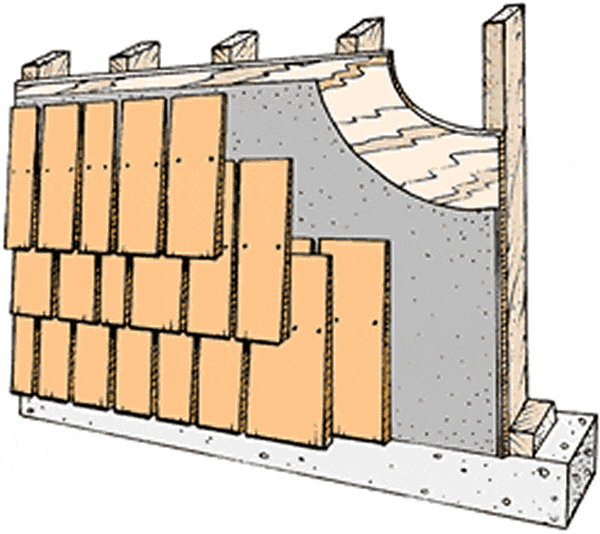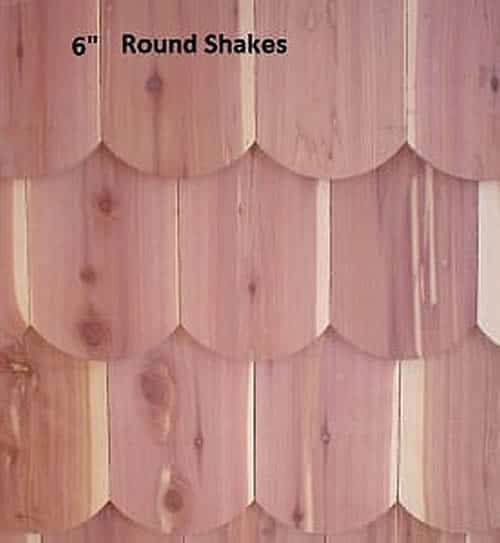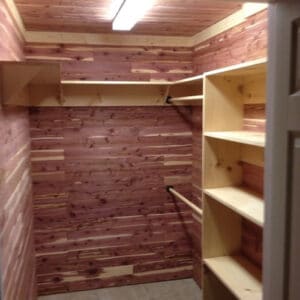Description
Cedar and Pine Shake Siding
- Each Bundle approx. 50sf'
- Each Shake approx. 6" inches wide
- Each shake approx. 16" inches long
- Approx 1/8′ tapering to 7/16′ thick
- Approx 72 shakes per square
Our beautiful red cedar and spruce pine shakes can be used for many different home projects. Our shakes are thicker than most national brands, which means that they will be looking better longer.
Cedar shake sizes will vary, however, no matter the Cedar Shake size, one square of cedar shakes will cover approx. 50 square feet with approx. 72 shakes per square. Our shakes come in a #1 and #2 graded mix.
Cedar Shakes and Shingles
Cedar shake siding and cedar shingle siding is the look most buyers crave when they consider real wood siding. Shakes and shingles can be used to cover the entire exterior or be installed in gables and other areas to complement wood or stone siding.
Traditionally, shakes were split by hand off a block of wood using a mallet and a blade called a froe. Cedar shakes are now machine-cut but also textured to give them a hand-split appearance. Our Shakes are approx 1/8′ tapering to 7/16′ thick, with a length of 16″.
- Dehumidified, Never Kiln Dried - Most, if not all, companies that ship Eastern Red Cedar will always kiln dry their products. When kiln dried, they takes the moisture content down to around 10-12%. This makes the wood lighter and saves money on shipping. Unfortunately, it also reduces the amount of cedar oils in the wood limiting the natural benefits and the very reason you are installing a cedar closet. Our de humidification chamber dries the cedar perfectly to maintain the wood’s natural scent, fiber texture, and color.
- Cut Fresh - There is no place we have found, or know of, that will custom cut, and ship, 1/2 inch aromatic eastern cedar wood for closet liners. When we started this business our goal was to help everyday people, with or without carpentry skills, who want to easily install the best cedar closet lining with the least amount of work. Ten years later, and thanks to our wonderful customers, we are the webs #1 seller, and shipper, of custom cut 1/2 inch aromatic eastern red cedar closet liners.
- Appearance Grade Cedar -Cedar is graded based on Appearance, which is called "appearance grade" or Select Lumber. Appearance grade is primarily for non-structural lumber under 2" thick. Appearance grades use letters A through D, with A being the highest grade. All of the cedar that we sell for closet liners is A grade Appearance Board eastern red cedar.

| Specification | Detail |
|---|---|
| Approx. Pre-Planing Length | 16" inches |
| Thickness (in.) | Approx 1/8′ tapering to 7/16′ thick |
| Width (in.) | Approx 6" inches |
| Board Joint Type | Square Edge |
| Bundle (sq. ft.) | Approx. 50'sf at 15" Exposure |
| Finish Type | None |
| Is Returnable | No |
| Lumber Grade | Appearance Board |
| Moisture content | Dehumidified |
| Saw Cut | Rough |
- All advertised sizes are approximate.
- Due to custom cutting & milling there are no refunds.
- We Offer Free Shipping on Many Items
- Free t-Shirt on all orders over $400.00
- Got a Question? No Problem! Call toll-free for Ordering Support 1-800-422-9912.
How to Install Cedar Shake Siding

Begin at the Bottom
Starting at the bottom of a wall, place the row of the starter strip of the #1 wood shingles in place. This will be the initial point of reference and will determine the placement of the rest of the shingles. Using the nail gun, attach this starter row securely to the existing siding and through the framing 2x4s of the wall structure.
Next, using a tape measure, level and the chalk box, snap a straight line across this bottom row of wood shingles. Using the nail gun, drive a single nail at one end of a cedar shake piece of siding, and then carefully align it along the snap line, attaching another nail at the opposite end. Go back and nail subsequent nails along the top edge of this cedar shake siding piece.
Step 1 - Measure your shingle line
Before you can start mounting your cedar shake siding, you will need to mark out your rows so that they don't slowly arch up or down as they are being secured. Start in bottom left of your outside wall and measure half of your shingles length from the base of your wall that will be getting the new siding. This is going to be your first row, mark this on both sides of your wall and then use your chalk line to snap a line across it as a guide. You can adjust this so that more or less of the shingles will hang below the bottom edge of your wall, by simply adjusting the measurement.
Step 2 - Begin with a Starter Row
Start on the left side and begin mounting the cedar shake siding on panel at a time. Do not over nail these, as they will crack and split, and cause them to be more structurally in-stable. If you are using two different types of shingle for a special effect, simply stagger them as you go, and try to stick with the same pattern row to row, or you can even mix them up.
Step 3 - Stagger the rows as you go
keep mounting and chalking lines row after row as you mount your cedar shake siding. Be sure that the line between the shingles in the lower rows are centered under the center of the shingle above it. This allows water to flow downward off your wall once you are done, and not into your outer walls causing mold and damage. On the ends of rows, or at the start of rows, use your utility knife to trim the first and last shingles to allow the overlapping as you go.
Step 4 - The Top Row
Once you have done all your rows to the top of your wall near the roof and trim, you will cut the tops off of your shingles following the same pattern and then tap them into place. You can coat the tops of these with wood glue if desired to prevent them from simply falling out during the changes in weather. You can use a rubber mallet to tap them into place from the bottom and to avoid cracking and breaking them from using your hammer. Follow the row along and trim up the ends as normal, and your cedar shake siding is done.
We Only Sell Aromatic Eastern Red Cedar
Our cedar panels can be used for closet liners, V-paneling and flooring. Our dehumidification chamber dries the cedar perfectly to maintain the wood’s natural scent, fiber texture, and color.
Eastern Red Cedar (Juniperus Virginiana) is extremely resistant to and repels many types of pests, such as rodents, roaches and termites. Please take note: that most cedar products on the market are Western Cedar. Our Eastern Cedar products offer better durability and insect repellents. Not even carpenter bees will want to bore into our wood!
Red Cedar is not only a beautiful, durable wood, but it also has an AMAZING scent! This type of wood was commonly used by noblemen, royalty and Native Americans (Cherokee Indians) in both modern and Biblical times. All of our wood is hand-selected premium grade planed Red Cedar. Our flooring, trim, and lap-siding products can be used for closet liners, churches, basements, garages, tiny homes, log homes, tree houses and much more.
We also sell Cedar Siding products to fit your needs. There are an assortment of Cedar Shakes in various shapes and sizes available for your selection. Lap siding is also available in our store. Our Products can be used for interiors and exteriors. Use as Siding, Paneling, Flooring, and more!
| Attribute | Detail |
|---|---|
| Common Name | Aromatic Red Cedar, Eastern Redcedar |
| Scientific Name | Juniperus virginiana |
| Distribution | Eastern North America |
| Tree Size | 100-115 ft (30-35 m) tall, 3-4 ft (1-1.2 m) trunk diameter |
| Average Dried Weight | 33 lbs/ft3 |
| Specific Gravity | 44, .53 |
| Janka Hardness | 900 lbf (4,000 N) |
| Color/Appearance | Heartwood tends to be a reddish or violet-brown. Sapwood is a pale yellow color, and can appear throughout the heartwood as streaks and stripes. |
| Grain/Texture | Has a straight grain, usually with knots present. Has a very fine even texture. |
| Endgrain | Resin canals absent; earlywood to latewood transition gradual, grain moderately uneven to moderately even; tracheid diameter small to very small; zonate parenchyma (double ring). |
| Rot Resistance | Regarded as excellent in resistance to both decay and insect attack, Aromatic Red Cedar is frequently used for fence posts used in direct ground contact with no pre-treating of the wood. |
| Workability | Overall, Aromatic Red Cedar is easy to work, notwithstanding any knots or irregularities present in the wood. It reportedly has a high silica content, which can dull cutters. Aromatic Red Cedar glues and finishes well, though in many applications, the wood is left unfinished to preserve its aromatic properties. |
| Odor | Aromatic Red Cedar has a distinct and tell-tale scent: the wood is commonly used in closets and chests to repel moths and other insects. |
| Common Uses | Fence posts, closet and chest linings, carvings, outdoor furniture, birdhouses, pencils, bows, and small wooden specialty items. |
About Red Cedar
Eastern red cedar grows in the eastern part of the United States, typically ranging between 20′-100′. Sometimes referred to as “aromatic cedar,” this cedar is known for its pungent scent from its natural oils. This cedar’s exterior boasts a reddish-violet tinted brown, while its inner sapwood appears pale yellow. The sapwood often makes an appearance throughout the heartwood.
The terms “red cedar” and “aromatic cedar” are markedly different in their context. Red cedar is a lay, or common, term. In a scientific context, the taxonomical names of trees -- Thuja plicata and Juniperus virginiana -- are used. Aromatic cedar, on the other hand, is a trade term used by carpenters, contractors and other professionals in the building trade.
The term refers specifically to the lumber of the eastern red cedar. It differs from the term “red cedar” in that red cedar refers to the tree as a whole, while “aromatic cedar” specifically denotes the wood of the eastern red cedar that is used in building projects and sometimes only building project lumber culled from specimens of eastern red cedar found in the southern portions of the Appalachian Mountains.
Conifer. Height 40 to 60 feet. Trunk diameter 2 to 4 feet. Usually a small tree, it has been known to grow 90 feet high with a trunk circumference of 13 feet. Distribution; Nova Scotia south to Georgia along the Atlantic Coast west to the Mississippi River states. It is the state tree of Tennessee. The eastern or "aromatic" red cedar is the species used for moth-proof storage chests and clothes closets. It is not to be confused with the huge timber species of the west coast: western red cedar and incense cedar.
A firm, stable softwood, the timber of this red cedar is highly prized for its beautiful, warm, deep, rich, red color and its most distinctive, everlasting, aromatic perfume. The wood is light and easy to work. It has numerous knots that make a handsome distinctive pattern. Otherwise it is straight and close grained. Due to its natural beauty and scent, it is never painted or stained. The wood is enduring - it is strong and durable. Its natural oils contain the secret of its success
Where aromatic red cedar is concerned, the knottier the wood the better. The many knots indicate the exceptionally high content of the aromatic oils that distinguish this wood from all others. The more oil the stronger the scent; the stronger the scent the deader the moth! (And, of course, the more wonderful smelling the stored woolen clothes.) This same oil makes cedar decay and insect resistant and waterproof; the perfect wood of choice for long term use. The wood also has low shrinkage and is very stable once applied.
Despite its relatively high cost, aromatic red cedar is worth the cost for the service it performs. It is typically available as veneer and lumber. The trunks of the majority of this red cedar are used for fence posts. The water resistant lumber is used in greenhouse construction and for window sills and small boat decks.
It is most commonly associated with cedar blanket chests, wardrobes, clothes closet interiors, storage room paneling and dresser drawer linings. It is also used for scientific instruments and novelties. The pencil in your hand or behind your ear is made of red cedar woods. This soft but firm, straight, close-grained wood is designed to sharpen perfectly and easily. Also, the shavings smell nice. Isn't nature grand!
Have Questions?
Please give us a call, or shoot us a line and we will be happy to help you with your project or concerns.
(800) 422-9912












